| Fig. 1. |
 |
The Project Gutenberg EBook of A Treatise on Simple Counterpoint in Forty Lessons, by Friedrich J. Lehmann This eBook is for the use of anyone anywhere at no cost and with almost no restrictions whatsoever. You may copy it, give it away or re-use it under the terms of the Project Gutenberg License included with this eBook or online at www.gutenberg.org Title: A Treatise on Simple Counterpoint in Forty Lessons Author: Friedrich J. Lehmann Release Date: July 21, 2005 [EBook #16342] Language: English Character set encoding: ISO-8859-1 *** START OF THIS PROJECT GUTENBERG EBOOK A TREATISE ON SIMPLE *** Produced by David Newman, Dainis Millers and the Online Distributed Proofreading Team at https://www.pgdp.net
The purpose of this work is to supply the need in the Oberlin Conservatory of Music of a text-book on Simple Counterpoint containing a definite assignment of lessons, and affording more practice than usual in combining species.
It is a treatise on strict counterpoint, but strict in a limited sense only. In two-part counterpoint with other than the first species in both parts, dissonances are permitted under certain conditions, and in three- and four-part writing the unprepared seventh and ninth, and the six-four chord, are allowed in certain ways.
While the illustrations have been written in close score, it is nevertheless urged that all exercises be written out in open score, as the movement of the different parts is thus more clearly seen.
The use of the C-clefs is left optional with the teacher.
A knowledge of harmony is presupposed, hence nothing is said pertaining to it.
The author wishes to express his indebtedness to Professor A.E. Heacox for his help and advice.
F.J. LEHMANN.
Oberlin, Ohio, Jan. 6, 1907.
| PAGE | |
| SIMPLE COUNTERPOINT | |
|---|---|
| LESSON I. Definitions and Illustrations. | 1-2 |
| SIMPLE COUNTERPOINT IN TWO PARTS | |
| First Species: Note against Note. Examples and Exercises. | 3-5 |
| LESSON II. Second Species: Two Notes against One. Examples and Exercises. | 6-9 |
| LESSON III. Second Species in Both Parts. Examples. Second Species Mixed in Both Parts. Examples and Exercises. | 9-11 |
| LESSON IV. Third Species: Four Notes against One. First Species against Six Notes. Second Species Continuously in Both Parts. Examples and Exercises. | 11-15 |
| LESSON V. Third Species in Both Parts; Mixed. Third Species Continuously in Both Parts. Two Notes against Four; Two against Six; Three against Six. Examples and Exercises. | 15-17 |
| LESSON VI. Fourth Species: Two Notes Syncopated against One. Three Notes Syncopated against One. Two Notes against Four; Two against Six; Three against Six. Examples and Exercises. | 17-19 |
| LESSON VII. Fourth Species (continued). Mixed, in Both Parts. Three Notes Syncopated against One. Examples and Exercises. | 19-20 |
| LESSON VIII. Fourth Species (continued). Two Notes Syncopated against Two; Two against Four; Two against Six; Three against Six. Examples and Exercises. | 20-22 |
| LESSON IX. Fifth Species: Florid Counterpoint. Examples and Exercises. | 22-24 |
| LESSON X. Florid Counterpoint (continued). Combining Fifth Species with Second; with Third; with Fourth; with Fifth. Examples and Exercises. | 24-25 |
| SIMPLE COUNTERPOINT IN THREE PARTS | |
| LESSON XI. First Species in All Parts. Examples and Exercises. | 26-28 |
| LESSON XII. Second Species in One Part. Examples and Exercises. | 28-31 |
| LESSON XIII. Second Species in Two or More Parts. First and Second Species Mixed in All Parts. Second Species in All Parts. Examples and Exercises. | 31-33 |
[vi]
LESSON XIV. Third Species in One Part. Second Species in All Parts.
Examples and Exercises. |
33-34 |
| LESSON XV. Third Species in Two or More Parts. First and Third Species Mixed in All Parts. Examples and Exercises. | 34-36 |
| LESSON XVI. Third Species (continued). Mixing First, Second, and Third Species in All Parts. Third Species in All Parts. Examples and Exercises. | 36-37 |
| LESSON XVII. Fourth Species in One Part. Three Notes Syncopated in One Part. Combining First, Second, and Third Species. Examples, and Exercises. | 37-39 |
| LESSON XVIII. Fourth Species (continued). Mixed in All Parts. Combining First, Second, and Fourth Species, and First, Third, and Fourth. Examples and Exercises. | 40-41 |
| LESSON XIX. Fifth Species in One Part. Examples and Exercises. | 41 |
| LESSON XX. Fifth Species (continued). Combining First, Second, and Fifth; First, Third, and Fifth; First, Fourth, and Fifth; Fifth in Two Parts. Example and Exercises. | 42-43 |
| LESSON XXI. Combining the Various Species: Second, Third, and Fourth; Second, Third, and Fifth; Second, Fourth, and Fifth; Third, Fifth, and Fifth; Fourth, Fifth, and Fifth. Examples and Exercises. | 44-45 |
| LESSON XXII. Fifth Species in All Parts. Examples and Exercises. | 45 |
| SIMPLE COUNTERPOINT IN FOUR PARTS | |
| LESSON XXIII. First Species in All Parts. Examples and Exercises. | 46 |
| LESSON XXIV. Second Species in One Part. Examples and Exercises. | 47 |
| LESSON XXV. Third Species in One Part. Second Species Mixed in Three Parts. Examples and Exercises. | 47-48 |
| LESSON XXVI. Third Species (continued). Mixed in Three Parts. Second Species Continuously in Two Parts. Examples and Exercises. | 48-49 |
| LESSON XXVII. Fourth Species in One Part. A Cantus Firmus with First, Second, and Third Species in the Other Three Parts. Examples and Exercises. | 49-50 |
| LESSON XXVIII. Fourth Species (continued). A given Cantus Firmus, with First, Second, and Fourth Species; with First, Third, and Fourth; with Fourth Species Mixed. Examples and Exercises. | 50-51 |
| LESSON XXIX. Fifth Species in One Part. Examples and Exercises. | 52 |
| LESSON XXX. Fifth Species in Two Parts. Mixing Second, Third, and Fourth Species in All Parts. Combining First, Second, Third, and Fourth Species. Examples and Exercises. | 52-54 |
| LESSON XXXI. Fifth Species in Three or Four Parts. Examples and Exercises. | 54-55 |
| LESSON XXXII. Fifth Species in All Parts, with Imitation. Examples and Exercises. | 55 |
|
[vii]
FLORID MELODIES AS CANTI FIRMI | |
| LESSON XXXIII. Two-part Florid Counterpoint. Free Harmonization. Examples and Exercises. | 55-58 |
| LESSONS XXXIV and XXXV. Three-part Florid Counterpoint. Free Harmonization. Examples and Exercises. | 58-59 |
| LESSON XXXVI. Three-part Florid Counterpoint (continued). Exercise in Original Writing. | 59 |
| LESSONS XXXVII to XL. Four-part Florid Counterpoint, Example and Exercises. | 60 |
Counterpoint is the art of combining two or more melodies of equal melodic individuality.
In simple counterpoint all parts must remain in the same relative position to one another.
The Cantus Firmus is a given melodic phrase that is to receive contrapuntal treatment, that is, one or more parts are to be added above or below it.
The Counterpoint is any part other than the Cantus Firmus.
Intervals are harmonic or melodic.
An Harmonic interval is the difference in pitch between two tones sounding at the same time.
A Melodic interval is the difference in pitch between two tones sounded in succession by the same voice. [Fig. 1.]
| Fig. 1. |
 |
Harmonic intervals are divided into Consonances and Dissonances.
Consonances are classed as perfect or imperfect.
The Perfect consonances are the Unison, Fifth, and Octave. [Fig. 2a.]
The Imperfect consonances are the Major and Minor Thirds and Sixths. [Fig. 2b.]
All other intervals are dissonances.
| Fig. 2. |
 |
A Diatonic progression is one in which both name and pitch are changed. [Fig. 3a.]
A Chromatic progression is one in which the pitch is changed a semitone, while the name remains the same. [Fig. 3b.]
| Fig. 3. |
 |
Progression from one chord to another is called Harmonic progression; from one tone to another, Melodic progression.
In melodic progression all major, minor, perfect and diminished intervals are allowed except the major and minor seventh. The minor seventh may, however, be used when harmony does not change (a). [Fig. 4.]
| Fig. 4. |
 |
In counterpoint there are Five Species, or orders. When the counterpoint has one note for each note of the cantus firmus, it is of the First Species (a); if it has two notes for each note of the cantus firmus, it is the Second Species (b); if four notes, the Third Species (c); if two notes syncopated, the Fourth Species (d); and a mixture of these species is the Fifth Species, or Florid Counterpoint (e). [Fig. 5.]
| Fig. 5. |
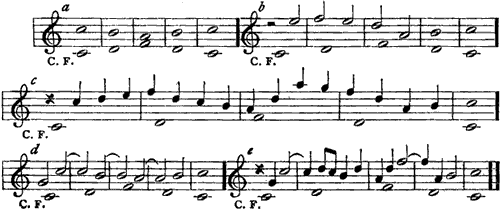 |
Two-part counterpoint comprises a cantus firmus and a counterpoint. [Fig. 6.]
| Fig. 6. |
 |
Although in two-part counterpoint we have to deal with intervals, rather than harmonies, still the harmonic progressions represented by these intervals should be regarded.
The exercises should begin and close with tonic harmony. At the beginning the unison, fifth or octave, and at the close the unison or octave, are permitted. [Fig. 7.]
| Fig. 7. |
 |
After the first measure it is better to use imperfect consonances only. The perfect consonances, however, may be used sparingly when a more melodious counterpoint is thereby obtained.
The unison may be used in the first and last measures only. [Fig. 7.]
All progressions must be diatonic, and parts should not cross.
The repetition of a note in a lower part should be avoided wherever possible. In a higher part, repetition to the extent of three notes in succession is allowed.
Do not use more than three thirds or sixths in succession. [Fig. 8.]
| Fig. 8. |
 |
Successive similar skips, except the minor third (a), in one direction, are to be avoided. Successive skips of a fourth are good when the tones are the fifths of the triads on I, IV and vii°. The last tone should return one degree (b). [Fig. 9.]
Do not move more than an octave in one direction in two skips. [Fig. 9c.]
| Fig. 9. |
 |
Covered fifths and octaves, except from I to V, or V to I, are forbidden. [Fig. 10.]
| Fig. 10. |
 |
Both parts skipping in contrary motion to a fifth or octave should be avoided in two-part writing. [Fig. 11.]
| Fig. 11. |
 |
Avoid consecutive perfect intervals. [Fig. 12.]
| Fig. 12. |
 |
The augmented fourth (Tritone) is not only considered bad as a melodic interval by some authorities, but its appearance between different parts in successive intervals is also prohibited. This prohibition, however, holds good only when the chords in which it appears are in fundamental position, as in Fig. 13a. This is shown by the fact, that if one part skips as at b, there is no unpleasant effect.
| Fig. 13. |
 |
Avoid consecutive major thirds in major keys. In minor keys they are good. [Fig. 14.]
| Fig. 14. |
 |
Use adjacent voices in writing, and do not exceed the vocal compass of a voice.
Modulation may be resorted to within the exercises, but only to nearly related keys; for example, in C, to G, F, a, e, or d.
At the close parts should proceed stepwise to the unison, or octave. [Fig. 15a.]
A close as in Fig. 15b may be used occasionally. In this case the leading-tone is better in the higher part.
| Fig. 15. |
 |
To each of the following canti firmi write two counterpoints above, and two below.
| Fig. 16. |
 |
| Fig. 17. |
 |
All rules for the first species must be observed.
Two notes are written in the counterpoint to one of the cantus firmus, except in the last measure. [Fig. 18a.] In the last measure but one the first species may sometimes be used. [Fig. 18b.]
| Fig. 18. |
 |
Repetition of a note in any but the first species is forbidden. [Fig. 19.]
| Fig. 19. |
 |
The counterpoint may begin on the first or the second half of the measure, preference being given to the second half. When it begins on the first half it must be a unison, fifth, or octave; when on the second half, it may be any consonance. [Fig. 20.]
| Fig. 20. |
 |
After the first measure the interval on the first beat should be an imperfect consonance, as in the first species, but the fifth, or octave, may be used occasionally.
In this and succeeding lessons, all notes in the measure not belonging to the harmony implied on the first beat, must be treated as dissonances, e.g., those belonging to the implied harmony may be left by a skip (a) or stepwise progression (b) unless dissonant with the cantus firmus; then avoid their use; if foreign [7] to it, whether consonant (c) with the C.F. or not (d), they must be treated as embellishments or passing-tones. [Fig. 21.]
| Fig. 21. |
 |
The embellishment may be used as follows: when above the principal tone, it may be a semitone (a) or a whole tone (b) distant from it; and when below, a semitone (c). [Fig. 22.]
| Fig. 22. |
 |
When the counterpoint is below the cantus firmus, the fifth of the chord needs special treatment. It is permitted on the weak beat when the lower is treated as an harmonic passing-tone.
An harmonic passing-tone is the second of three tones belonging to the same chord. [Fig. 23a.] While the third tone should be a member of the chord containing the fifth as an harmonic passing-tone, the chord above it may change as in Fig. 23b.
The fifth is permitted on the strong beat when it is only an implied fifth (six-four chord); that is, the third and fifth appear on the strong beat, and the root does not come in until the second half of the measure. [Fig. 23c.]
| Fig. 23. |
 |
The unison is permitted on the weak beat. [Fig. 24.]
| Fig. 24. |
 |
Avoid broken-chord effects, that is, do not use more than three tones belonging to the same chord in succession. [Fig. 25.]
| Fig. 25. |
 |
Avoid frequent skipping of parts. [Fig. 26.]
| Fig. 26. |
 |
Parts may cross occasionally, but should return immediately [Fig. 27.]
| Fig. 27. |
 |
Consecutive fifths or octaves on consecutive strong beats are bad; but they are good on the weak beats if the second fifth or octave is approached in the opposite direction from the first. [Fig. 28.]
| Fig. 28. |
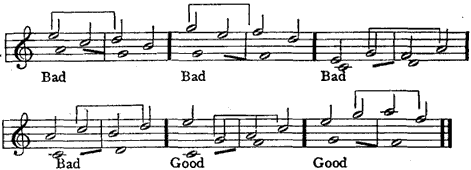 |
In minor the sixth degree may occasionally be raised on the strong beat, if it is desired to proceed upward to the raised seventh degree. [Fig. 29.]
| Fig. 29. |
 |
In the last measure but one, both the supertonic and leading tone should appear. [Fig. 30.]
| Fig. 30. |
 |
Three notes may be written to one of the cantus firmus, as in Fig. 31. For this no new rules are required.
| Fig. 31. |
 |
The cadences in Fig. 32 are good. It will be seen that the cadences of the first species may also be used.
| Fig. 32. |
 |
To cantus firmus a write two counterpoints above and two below in the first species.
To cantus firmus b write two above and two below in the second species.
| Fig. 33. |
 |
| Fig. 34. |
 |
[A] In this and similar cases the term "species" will be understood as referring simply to the number of notes, or to the note-combinations, of the contrapuntal part or parts in question. "Second species in both parts" means, therefore, that both parts progress in half-notes.
When writing second species in both parts no cantus firmus is used, both parts being original. One part begins on the first beat, the other may begin on either the first or second beat. [Fig. 35.]
| Fig. 35. |
 |
The interval formed by the two notes appearing on the second beat should be a consonance, or one of the following dissonances: The augmented fourth, the diminished fifth, the minor or diminished seventh when properly resolved, and the perfect fourth when approached in contrary motion.
All tones not belonging to the harmony implied on the first beat, must be treated as dissonances. [Fig. 36.]
| Fig. 36. |
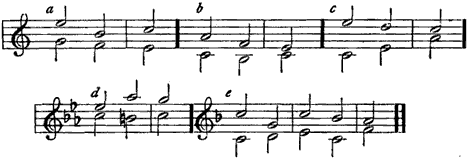 |
The seventh or ninth of the implied harmony of a measure, when approached in an upward direction, may be used in either part, provided it is consonant with the other part, or comes within the requirements of the exceptions. [Fig. 37.]
The passing major seventh and its root may appear on the weak beat, even when approached in similar motion as in Fig. 37a. The seventh must then be treated as a passing-tone.
| Fig. 37. |
 |
The cadences in Fig. 38 are good when writing second species in both parts. Those having the second species in one part only, may also be used.
| Fig. 38. |
 |
Writing the second species in both parts will, in this lesson, be confined to a mixture of the first and second species, as in Fig. 39.
In this do not use the second species more than four measures continuously in one part. It will be noticed that the second species may occasionally be used in both parts. In later lessons opportunity will be given to write it continuously in both parts.
| Fig. 39. |
 |
Write two eight-measure phrases mixing the first and second species. [Fig. 39.]
To cantus firmus a write one counterpoint above and one below, three notes to the measure. [Fig. 31.]
To cantus firmus b write one above and one below, in the second species.
| Fig. 40. |
 |
| Fig. 41. |
 |
In this species, four notes are written in the counterpoint to each note of the cantus firmus. The counterpoint may begin on the first, second, or fourth quarter. The second quarter is, however, the most usual. [Fig. 42.]
| Fig. 42. |
 |
The exercises should begin and end with tonic harmony.
When the counterpoint begins on the first quarter it must form a perfect consonance with the cantus firmus. When on the second or fourth quarter, any consonance may be used.
All previous rules are to be regarded, unless exceptions are made.
At least one of the first three quarter-notes of a measure should be left degreewise. [Fig. 43.]
| Fig. 43. |
 |
The last quarter of a measure is usually left degreewise. If approached by a skip or by a degreewise progression of at least two quarter-notes, it may be left by a skip in the opposite direction from which it was approached. A skip of a third in the same direction is also good when this skip is preceded by a skip of a third (d). [Fig. 44.]
| Fig. 44. |
 |
Parts may cross occasionally.
The use of non-harmonic tones, as in Fig. 45, is good in either part. At a the passing-tone, instead of progressing directly to the adjacent chord-tone, skips a third to the other side of it and then returns. The embellishment is treated in the same way, but [13] is most effective when the principal tone is the leading-tone, as at b. In both cases the counterpoint should continue degreewise through the chord-tone. [Fig. 45.]
| Fig. 45. |
 |
The fifth, when in the lower part, may be used on any but the first quarter, provided it is treated as a passing-tone, e.g., approached and left by stepwise progression in one direction.
| Fig. 46. |
 |
Consecutive fifths and octaves are forbidden when appearing on the accented beats of successive measures; between prominent notes of successive measures not more than four quarters apart; and between a prominent note of one measure and the first quarter of the next. [Fig. 47.]
| Fig. 47. |
 |
Oblique motion to the unison is bad. It is permitted if it continues in the same direction through the unison. [Fig. 48.]
| Fig. 48. |
 |
The unison may be used on any but the first quarter of a measure.
Frequent repetition of a figure as in Fig. 49 is not good.
| Fig. 49. |
 |
The embellishment may be used either above or below, whether a semitone or a whole tone; but when it is a whole tone below, it is most satisfactory as the ninth of the implied chord. [Fig. 50.]
| Fig. 50. |
 |
In minor the sixth and seventh degrees of the scale are raised both ascending and descending, when used in harmonies containing the leading-tone as a chord-tone. They are unaltered both ascending and descending in harmonies containing the sixth degree of the scale as a chord-tone. In other harmonies they are raised in ascending only.
The sixth or seventh degrees may be chromatically altered with only one note intervening. [Fig. 51.]
| Fig. 51. |
 |
Six notes may be written to one of the cantus firmus, as in Fig. 52.
| Fig. 52. |
 |
The cadences in Fig. 53 are good.
| Fig. 53. |
 |
To cantus firmus a write three counterpoints above and three below, in the third species.
Write two eight-measure phrases, using second species continuously in both parts. [Fig. 34.]
| Fig. 54. |
 |
| Fig. 55. |
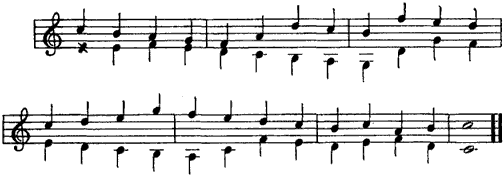 |
The suggestions given for writing second species in both parts apply here, except that when both parts move degreewise, any interval may come on the second and fourth quarters, preferably a consonance. The third quarter is treated the same as the second half when writing the second species in both parts.
The augmented fourth, and diminished fifth and seventh, may be approached in similar motion. [Fig. 56.]
| Fig. 56. |
 |
The augmented fourth following the perfect fourth, as in Fig. 56a, is good.
The minor seventh, and the major and minor ninth of a chord, may be used freely on any but the first quarter, but must be consonant with the other part. [Fig. 57.]
| Fig. 57. |
 |
The first and third species may be mixed, as in Fig. 58.
| Fig. 58. |
 |
The second species may be used in one part and the third in the other, also six notes in one part and two in the other, and six in one and three in the other. All tones appearing simultaneously, must comply with the suggestions for tones appearing on the weak beat given in previous lessons, where both parts have other than the first species. [Fig. 59.]
| Fig. 59. |
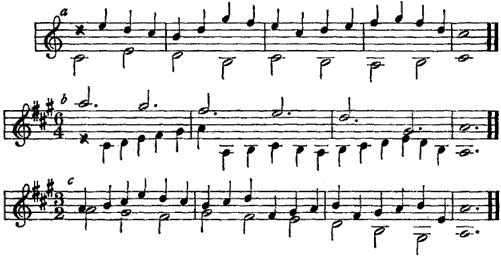 |
The cadences in Fig. 60 are good, and will suggest others.
| Fig. 60. |
 |
To cantus firmus a write one counterpoint above and one below, in the third species.
To cantus firmus b write counterpoints in six notes, one above and one below. [Fig. 52.]
Write one eight-measure phrase, mixing the first and third species. [Fig. 58.]
Write two eight-measure phrases, using third species in both parts. [Fig. 55.]
| Fig. 61. |
 |
| Fig. 62. |
 |
This species is the same as the second, except that the last note of the measure is tied to the first note of the next, forming a syncopation. As in the second species, the first note of the counterpoint should form a unison, octave or fifth, and when the counterpoint begins on the second half it may also be an imperfect consonance.
When the counterpoint begins on the first half, the second half is treated the same as the second half of succeeding measures, described in the next paragraph.
After the first measure, the second half of the measure should contain a consonance (Fig. 63a), the first half a consonance (b), or dissonance (c), preferably the latter, in which case a suspension is formed. This is the most desirable form of syncopation. When the first half contains a dissonance, the counterpoint must descend—or ascend in retardation (d)—one degree to an imperfect consonance (c). When the first half is a consonance, it may be left by a skip to some other chord-tone (e), or by degreewise progression (f). In the latter case the second note is non-harmonic, and therefore should not be used to prepare a syncopation except as in Fig. 63d (Retardation of the root in I6).
| Fig. 63. |
 |
When writing three notes to one in the fourth species, the suspension may resolve on the second beat (a), or the third (b). In the latter case, the suspension skips (c) to some other chord-tone, before resolving. The resolution to the leading-tone (d) forms an important exception to this rule. [Fig. 64.]
| Fig. 64. |
 |
The fifth may be used in the lower part if it becomes the preparation of a suspension (Fig. 65a). It may also be used in the lower part, as in Fig. 65b, provided it resolves by skipping to the third of the chord.
In skipping from the fifth to the root, or the reverse, in the lower part, do so in an upward direction. The fifth, when treated as an harmonic passing-tone, may, however, be approached either ascending or descending.
| Fig. 65. |
 |
The retardation should be used only when prepared by the leading-tone. It rises a semitone in resolving. [Fig. 66.]
| Fig. 66. |
 |
The following dissonant intervals may be used on the first half of the measure:—When the counterpoint is above, the fourth and seventh in suspension, and second and fifth in retardation; and when below, the second in suspension, and the fourth and seventh in retardation. [Fig. 67.]
| Fig. 67. |
 |
Consecutive fifths on consecutive strong beats of the measure are good when one of the tones of the second fifth is prepared, as in Fig. 68.
| Fig. 68. |
 |
The following cadences are good:
| Fig. 69. |
 |
Write one eight-measure phrase with two notes to the measure in one part and six in the other; one with three notes in one and six in the other; and one with two notes in one part and four in the other. (Fig. 59.) In combining the species in this and succeeding lessons the student may place any species in any part.
To the cantus firmus write two counterpoints above and two below, in the fourth species.
| Fig. 70. |
 |
The first and fourth species may be mixed as in Fig. 71. Rules for writing other than the first species in both parts are to be regarded.
| Fig. 71. |
 |
To cantus firmus a write two counterpoints above and two below, in the fourth species.
To cantus firmus b write two above and two below, three half-notes to the measure, with syncopations.
Write two eight-measure phrases, mixing the first and fourth species.
| Fig. 72. |
 |
All previous rules for combining species still apply.
In combining the fourth species with other than the first, the following intervals may be used on the first half of the measure, in addition to those mentioned in Lesson VI: When the counterpoint is below, the fourth, fifth and seventh in suspension, and the ninth in retardation; and when above, the fifth in suspension, and the seventh in retardation; but in every such case the part having other than the fourth species must skip to some other chord-tone before resolving the suspension. [Fig. 73.]
| Fig. 73. |
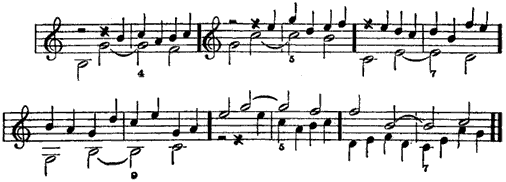 |
The leading-tone may be doubled as in Fig. 74. Here the leading-tone that is prepared skips to some other chord-tone, while the new leading-tone remains stationary.
| Fig. 74. |
 |
The minor or diminished seventh, major or minor ninth, may be used as preparation of a suspension in either part, provided it is approached by a skip in an upward direction, and is consonant with the other part, or is one of the permitted dissonances. [Fig. 75.]
| Fig. 75. |
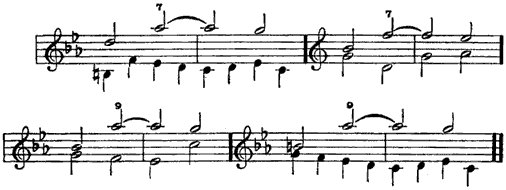 |
The fourth species may be combined with the second or third species, and two or three notes syncopated may be written in one part with six in the other. [Fig. 76.]
| Fig. 76. |
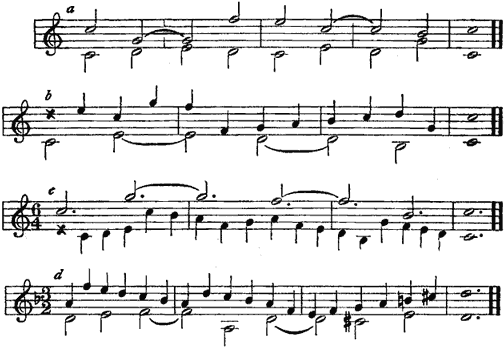 |
To the cantus firmus write one counterpoint above and one below, in the fourth species.
Write one eight-measure phrase each, of the following combinations: The fourth species with the second; the fourth with the third; two notes syncopated against six notes; and three notes syncopated against six notes. Write some in major and some in minor. [Fig. 76.]
| Fig. 77. |
 |
| Fig. 78. |
 |
Florid counterpoint is a mixture of the second, third and fourth species.
In addition to these species eighth-notes may be used in groups of two on the second and fourth quarters of the measure. Both notes should be approached and left stepwise, with the exception that the first may be taken by a skip. [Fig. 79.]
| Fig. 79. |
 |
Not more than one and one-half measures of any one species should be used continuously in one part. [Fig. 80.]
| Fig. 80. |
 |
In the use of quarter-notes it is necessary to exercise care. They may be used on the first half when preceded by quarter-notes, when the entire measure is filled, or when they precede a half-note which is the preparation of a suspension. On the second half they are always good. [Fig. 81.]
| Fig. 81. |
 |
For the present the suspension should not be less than a half-note or its rhythmic equivalent in the ornamental resolution.
In this species the suspension may resolve ornamentally, that is, it may have some note or notes interpolated between the suspension and its resolution. The relative position of the suspension and its resolution must remain the same as in the regular resolution. [Fig. 82.]
When the suspension is left by a leap, the note skipped to should be consonant with the other part (b). When eighth-notes are used, as at a, they must be approached and left stepwise.
The suspension, instead of being sustained as a half-note, may be repeated on the second quarter, as at c. In this case it is best to continue stepwise through the tone of resolution.
At d the resolution, instead of coming on the second half, appears on the quarters on either side. This is good.
| Fig. 82. |
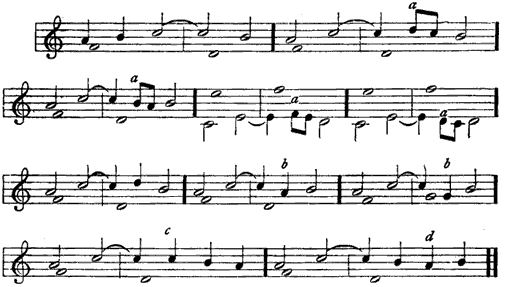 |
The ornamental resolution may be used in either part.
Use the suspension freely.
The solutions should be musical, and are to be written over and over again until such are secured.
All cadences of the second, third and fourth species, or any combination of these, may be used.
To canti firmi a and b write two counterpoints above and two below, in the fifth species
| Fig. 83. |
 |
When florid counterpoint is combined with other than first species, the dotted half followed by a quarter-note (a), or two [25] eighth-notes (b), is good. Also, a rhythmic figure, as at c, where a half-note occupies the second and third quarters, may be used. [Fig. 84.]
| Fig. 84. |
 |
Write one eight-measure phrase, each, of the following combinations: The fifth species with the second; the fifth with the third; and the fifth with the fourth. Write also two eight-measure phrases with fifth species in both parts. [Fig. 85.]
| Fig. 85. |
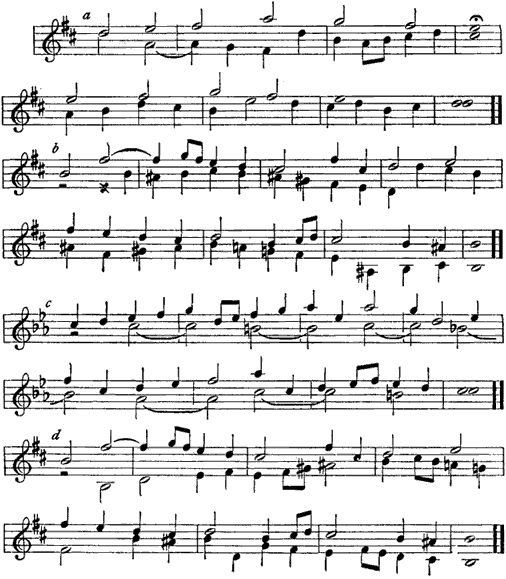 |
| Fig. 86. |
 |
Regard all rules for two-part counterpoint, unless otherwise mentioned.
If possible, each measure should contain a complete chord. When in the first species it becomes necessary to double an interval, let it be preferably the root. The third should be doubled only when a decidedly smoother melodic progression is thereby obtained; and when both thirds are in outer parts, each should be approached and left stepwise in one direction (Fig. 87). The doubling of the fifth is, of course, impossible, since it necessitates the omission of the third.
| Fig. 87. |
 |
All triads may be used in their first inversion.
Diminished and augmented triads, however, are best used in their first inversion.
The six-four chord may be used at the close as the cadencing tonic six-four chord. Do not approach the root and fifth in similar motion, as at b. [Fig. 88.]
| Fig. 88. |
 |
The dominant seventh may be used in any but its second inversion, the fifth being omitted.[A] The seventh requires no preparation. Other chords of the seventh are better not used until second species and later.
If possible, let the chord in the first measure appear complete. The last chord but one should be complete, unless some form of V or V7 is used. [Fig. 89.]
| Fig. 89. |
 |
Consecutive major thirds may be used when three or more parts are employed. [Fig. 90.]
| Fig. 90. |
 |
A note may now be repeated in the lowest part when it becomes the seventh of a dominant seventh-chord. [Fig. 91.]
| Fig. 91. |
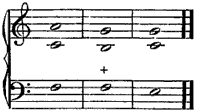 |
In writing, use soprano, alto and tenor, or alto, tenor and bass; and do not separate upper parts more than an octave. For a chord or two they may (for the sake of better voice-leading) separate a tenth.
All hidden fifths and octaves are bad, except between I and V and V and I. [Fig. 92a, b.]
[A] In severely strict counterpoint all parts above the lowest must be consonant with it. Dissonances, when entering simultaneously with it, must be treated as suspensions, and when used in the progression of a part from one chord to another, should be treated as passing-tones or embellishments. This excludes the use of the unprepared seventh and ninth; all diminished and augmented triads except in their first inversion; and all six-four chords, except when the lowest part is treated as a passing-tone.
The perfect fifth following the diminished fifth is good when taken in an upward direction stepwise in the higher parts. [Fig. 92c.]
| Fig. 92. |
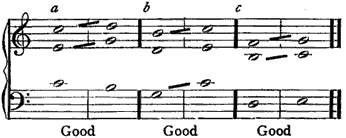 |
All cadences used in harmony are good.
Unless otherwise mentioned, put the cantus firmus in any part, but avoid its continued use in the same part.
To canti firmi a and b write the first species in all parts. Write each three times, setting the cantus firmus in a different part in each solution. This necessitates transposing the cantus firmus, when setting it in the other parts.
| Fig. 93. |
 |
| Fig. 94. |
 |
The second species is written in one part and the first in the other two.
All suggestions made for the second species in two-part counterpoint are to be observed, unless otherwise mentioned. Those regarding consecutive perfect intervals are especially to be observed.
The fifth, when in the lowest voice, should be used as in two-part counterpoint, except when used in V43 or the cadencing tonic six-four chord.
The V43 chord may be used on the weak beat, necessitating the omission of the third. [Fig. 95a.]
The third may be omitted (b), or doubled (c), on the weak beat in this and succeeding species. [Fig. 95.]
| Fig. 95. |
 |
The minor or diminished seventh may be approached by a skip in an upward direction on the weak beat in any part. This usually necessitates the omission of some other chord-member on the weak beat.
The major or minor ninth may also be used in the same way, except in the lowest part, provided it is at least a ninth above the root. [Fig. 96.]
| Fig. 96. |
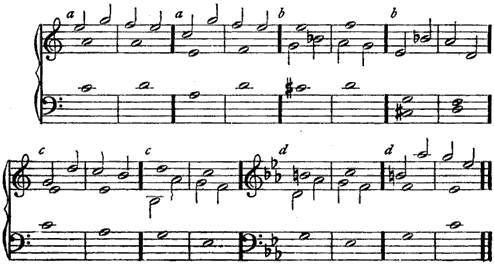 |
The progression from vii°6 to V in root-position or any inversion in the same measure, is good. [Fig. 97.] Use b and c only when using other than first species in two or more parts.
| Fig. 97. |
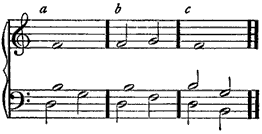 |
Each measure should usually contain a complete chord. If not complete on the first beat, bring the missing interval in on the second. [Fig. 98.]
| Fig. 98. |
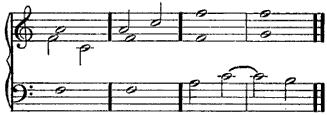 |
The cadences in Fig. 99 are good, and will suggest others. The use of the fourth species is permitted as at a. A note may be repeated in the final cadence in all species as at b.
| Fig. 99. |
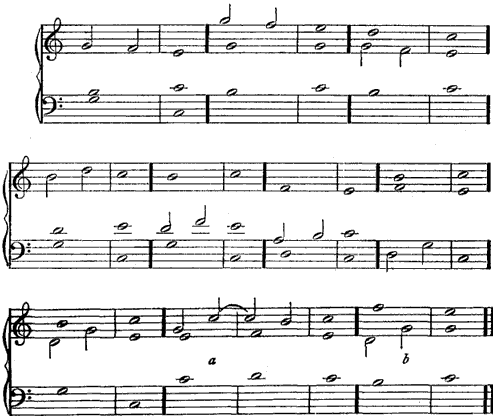 |
To cantus firmus a write the first species in all parts, as previously directed.
To cantus firmus b write second species in one part. Write three times, changing cantus firmus and counterpoint about so that they will appear in each part in turn.
| Fig. 100. |
 |
| Fig. 101. |
 |
The suggestions for second species in both parts, in two-part counterpoint, apply for the two parts having the second species in three-part counterpoint.
Accidental harmonies sometimes appear on the weak beat. All tones in this accidental harmony foreign to the chord on the strong beat must be treated as dissonances. This must be regarded whenever two or more parts have other than the first species. [Fig. 102.]
| Fig. 102. |
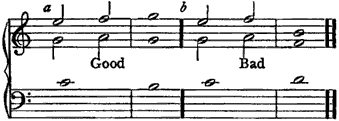 |
At Fig. 102a, the accidental harmony f-a-c is on the weak beat. The f and a, being foreign to the chord c-e-g on the strong beat, are correctly treated as dissonances. At b, the f and a are left by skip, which is not permitted.
The second species may be written continuously in all parts; the tones appearing on the weak beat must be harmonically related to one another, and those foreign to the chord on the strong beat must be treated as dissonances. [Fig. 103.]
| Fig. 103. |
 |
The first and second species may be mixed, as in Fig. 104.
| Fig. 104. |
 |
The cadences in Fig. 105 are good, and will suggest others. Those with first species in all parts may also be used.
| Fig. 105. |
 |
To cantus firmus a write a counterpoint in the second species in one part. Write three settings, as directed in the previous lesson.
Write two eight-measure phrases mixing the first and second species in all parts.
To cantus firmus b write counterpoints in the second species in the other two parts. Write two settings, with the cantus firmus in different parts.
| Fig. 106. |
 |
| Fig. 107. |
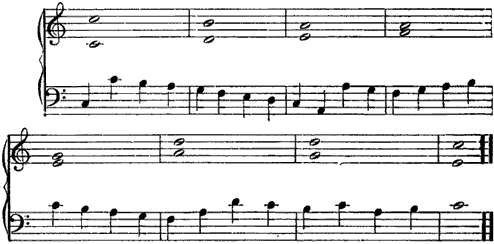 |
The suggestions for third species in two-part counterpoint, as well as those for writing the second species in three-part counterpoint, apply when writing third species in three-part counterpoint.
The cadences at Fig. 108 are good, and will suggest others.
| Fig. 108. |
 |
To cantus firmus a write third species in one part. Write three settings as previously directed.
To cantus firmus b write second species in two parts, as previously directed.
Write one eight-measure phrase, using second species in all parts.
| Fig. 109. |
 |
| Fig. 110. |
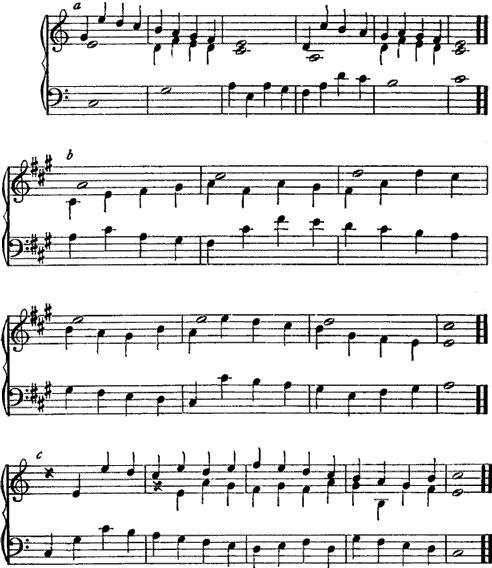 |
Previous suggestions when two or more parts have other than first species, apply here.
In using the ninth of a chord it is well to keep it at least a seventh distant from the third, as well as a ninth above the root, except in the case of the dominant ninth in minor keys, where it may be separated by only an augmented second ([b]). [Fig. 111.]
| Fig. 111. |
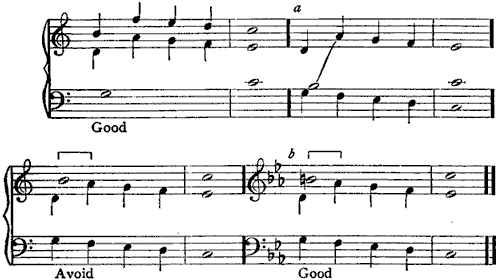 |
In writing the third species in all parts, notes appearing simultaneously should be harmonically related. Treat all tones foreign to the chord on the first quarter as dissonances.
The cadences in Fig. 112 are good.
| Fig. 112. |
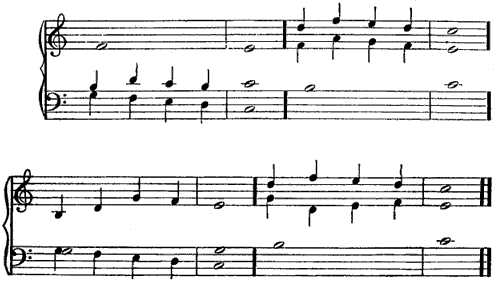 |
To cantus firmus a write third species in one part, as previously directed.
To cantus firmus b write third species in two parts, as in Fig. 110b. Write twice, changing the cantus firmus about.
Write one eight-measure phrase, mixing first and third species as in Fig. 110a.
| Fig. 113. |
 |
To the cantus firmus write third species in one part, as previously directed.
Write one eight-measure phrase, mixing first and third species; also one mixing first, second and third. [Fig. 114.]
Write one eight-measure phrase, using third species in all parts. [Fig. 110c.]
| Fig. 114. |
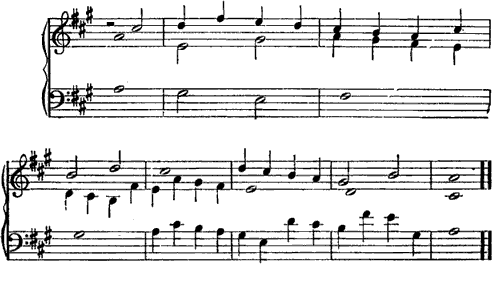 |
| Fig. 115. |
 |
| Fig. 116. |
 |
When the syncopation is a suspension or retardation, it is treated the same as in harmony.
The retardation should always be prepared by the leading-tone.
When the syncopated note belongs to the harmony of the measure, it may be left by a skip or stepwise progression. [Fig. 117.]
| Fig. 117. |
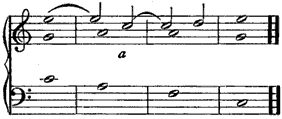 |
The third may be omitted on the strong beat in this species, provided the part having fourth species skips to the missing third, as at Fig. 117a.
Consecutive fifths, but not octaves, are saved by the suspension. Whenever they occur, do not use the note of resolution as [38] preparation of a suspension, or tie it into the next measure (a), since it is really the passing seventh, and that does not lend itself well to either of the above, except in sequence as at b. [Fig. 118.]
| Fig. 118. |
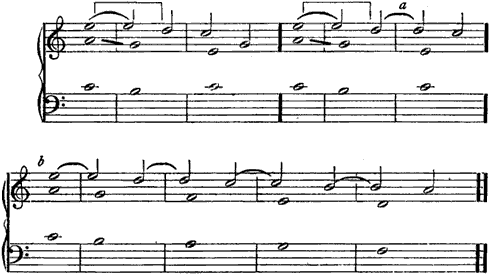 |
The seventh or ninth of a chord, except the major seventh, may be used as preparation of a suspension when approached by a skip in an upward direction, as in Fig. 119.
| Fig. 119. |
 |
This species may also be written in triple rhythm. [Fig. 120.]
| Fig. 120. |
 |
The cadences in Fig. 121 are good, as well as those of the second species.
| Fig. 121. |
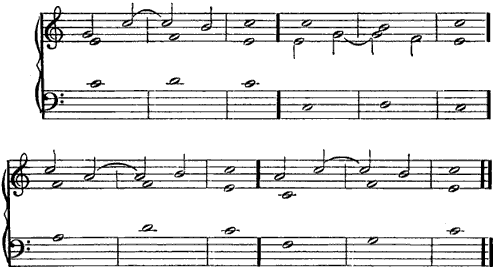 |
To cantus firmus a write fourth species in one part. Write three settings, as usual.
To cantus firmus b write fourth species in one part in triple rhythm. Write three settings, as above.
To cantus firmus b write second species in one part and third in the other. [Fig. 122.]
| Fig. 122. |
 |
| Fig. 123. |
 |
Write two eight-measure phrases, using the fourth species mixed in all parts. [Fig. 124a.]
To cantus firmus a write second species in one part and fourth in the other. [Fig. 124b.]
To cantus firmus b write third species in one part and fourth in the other. [Fig. 124c.]
| Fig. 124. |
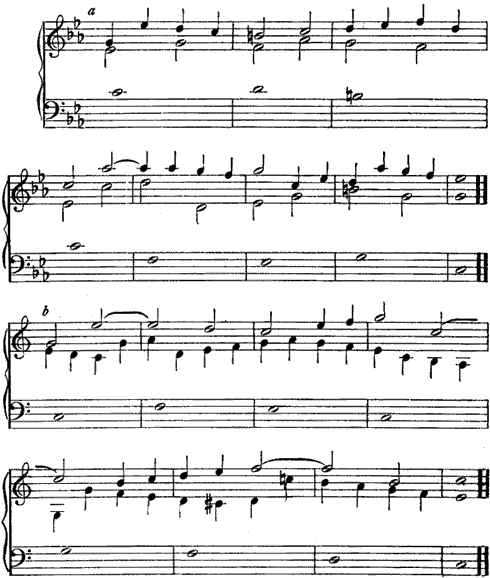 |
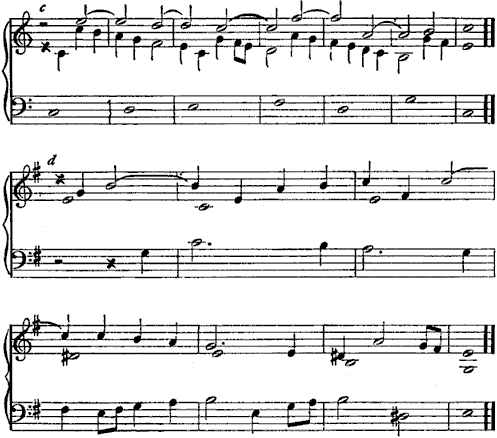
|
|
| Fig. 125. |
 |
| Fig. 126. |
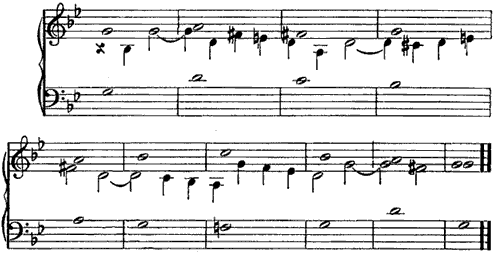 |
No suggestions other than have already been given for two- and three-part counterpoint are necessary for this species.
To canti firmi a and b write fifth species in one part. Write each three times, as usual.
| Fig. 127. |
 |
To cantus firmus a write second species in one part and fifth in the other. [Fig. 128a.]
To cantus firmus b write third species in one part and fifth in the other. [b.]
To cantus firmus c write fourth species in one part and fifth in the other. [c].
To cantus firmus d write fifth species in two parts. [d.]
| Fig. 128. |
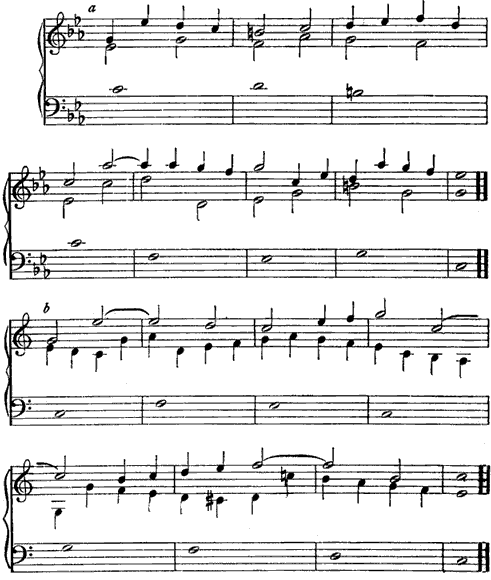 |
|
|
[43]
|
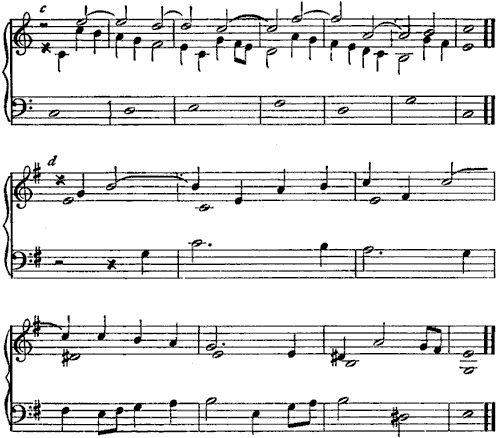
|
|
| Fig. 129. |
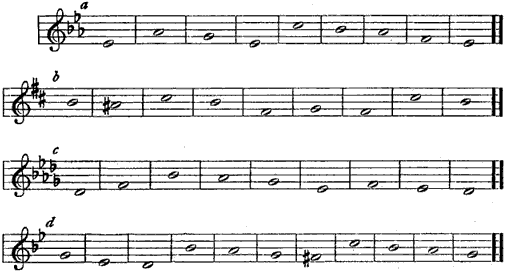 |
Write one eight-measure phrase each, of the following combinations: (1) 2nd, 3rd and 4th species (Fig. 130a); (2) 2nd, 3rd and fifth species (b) (3) 3rd, 5th and 5th species (c); (4) 2nd, 4th and 5th species (d); (5) 4th, 5th and 5th species (e).
| Fig. 130. |
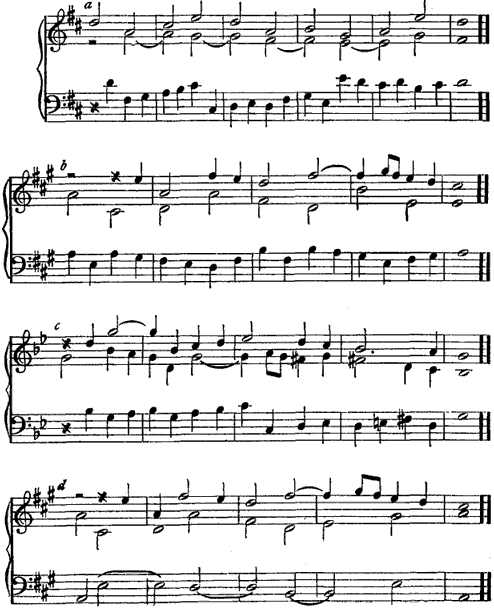 |
|
[45]
|

|
Write five eight-measure phrases with fifth species in all parts, making use of imitation at the beginning as in Fig. 131. The imitation need only be relative and continue for three or four notes. It is also well, when a part uses a striking melodic figure, to have some other part imitate it immediately after.
| Fig. 131. |
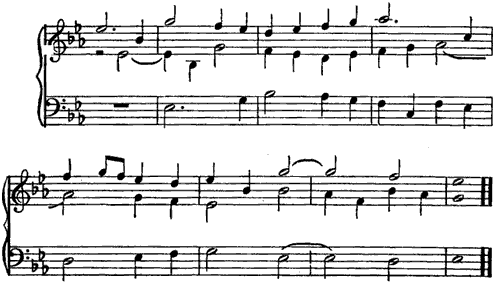 |
| Fig. 132. |
 |
No new suggestions are needed, except as follows: All covered fifths and octaves permitted in harmony are allowed here. When the cantus firmus is in the lowest part and the choice of the last chord but one is V43 or vii°6, use the latter, as in Fig. 133.
| Fig. 133. |
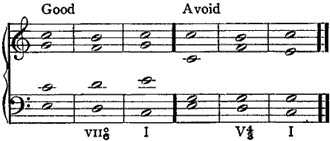 |
To canti firmi a and b write the first species in the other parts. Write each four times, setting the cantus firmus in each part in turn.
| Fig. 134. |
 |
| Fig. 135. |
 |
To cantus firmus a write the first species in all parts, as in the previous lesson.
To cantus firmus b write the second species in one part. Write four times, and change with each solution, so that both the cantus firmus and the second species will appear in each part. [Fig. 135.]
| Fig. 136. |
 |
| Fig. 137. |
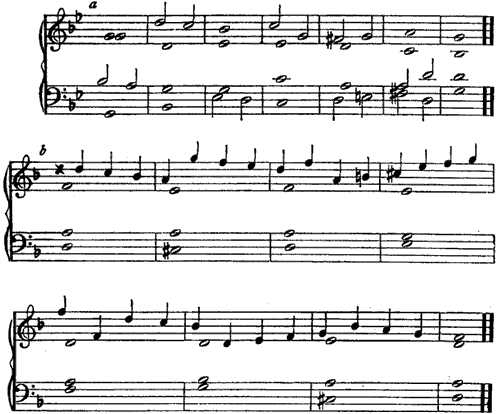 |
To cantus firmus a write second species in one part as previously directed.
To cantus firmus b write the first and second species mixed in the other three parts. [Fig. 137a.]
To cantus firmus c write third species in one part, as directed for the second species (b).
| Fig. 138. |
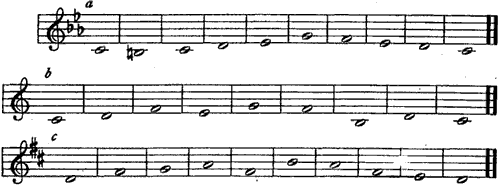 |
| Fig. 139. |
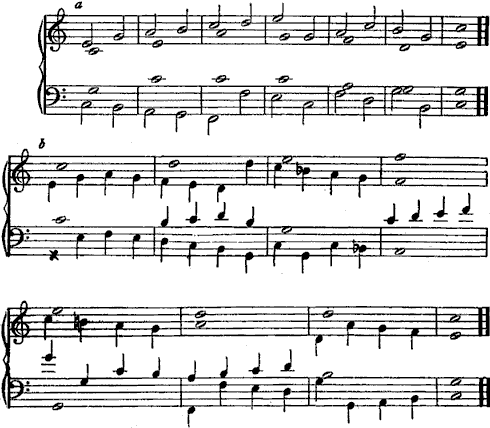 |
To cantus firmus a write the second species in two parts and the first in the others. Write twice, changing the parts about. [Fig. 139a.]
To cantus firmus b write third species in one part as previously directed.
To cantus firmus c write third species mixed in the other three parts, as at Fig. 139b.
| Fig. 140. |
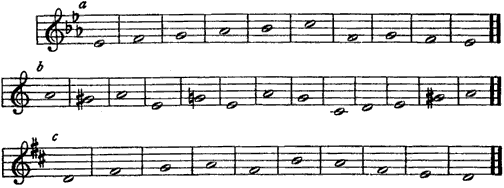 |
| Fig. 141. |
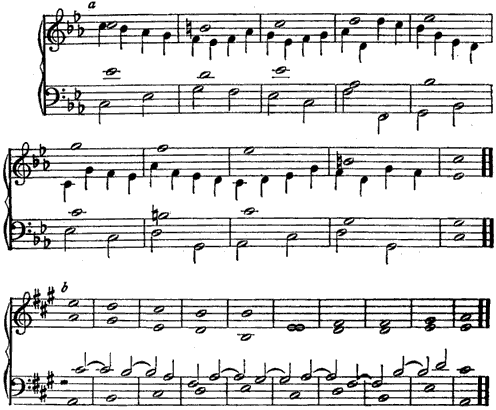 |
To cantus firmus a write the first, second and third species in the other three parts. Write twice, changing the parts about [Fig. 141a.]
To cantus firmus b write fourth species in one part, as directed in previous lessons. [Fig. 141b.]
To cantus firmus c write third species mixed in the other three parts. [Fig. 139b.]
| Fig. 142. |
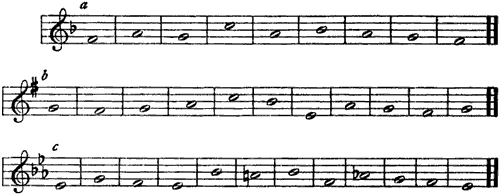 |
| Fig. 143. |
 |
|
[51]
|
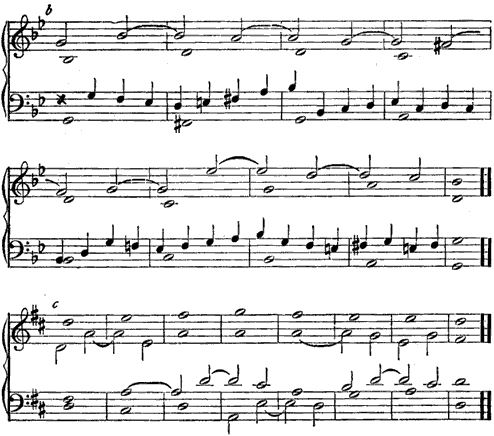 |
To cantus firmus a write the fourth species in one part, as usual.
To cantus firmus b write first, second and fourth species in the other three parts. [Fig. 143a.]
To cantus firmus c write the first, third and fourth species in the other three parts. [Fig. 143b.]
To cantus firmus c write fourth species mixed in the other parts. [Fig. 143c.]
| Fig. 144. |
 |
| Fig. 145. |
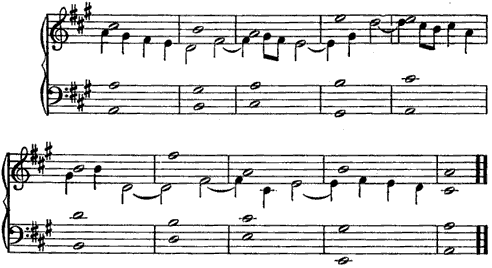 |
To canti firmi a and b write fifth species in one part, as before.
| Fig. 146. |
 |
| Fig. 147. |
 |
|
[53]
|
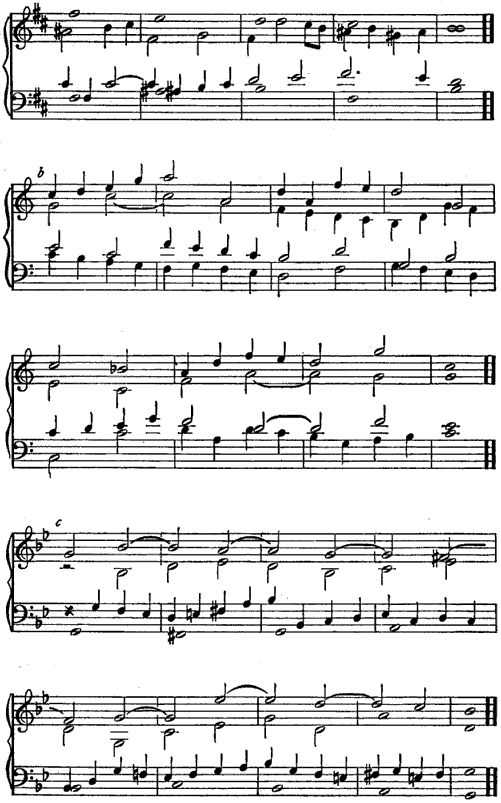 |
To the cantus firmus write the fifth species in two parts. Write four times, changing the cantus firmus into every part. [Fig. 147a.]
Write one eight-measure phrase mixing the second, third and fourth species (b). Also write one exercise combining the first, second, third and fourth species (c).
| Fig. 148. |
 |
| Fig. 149. |
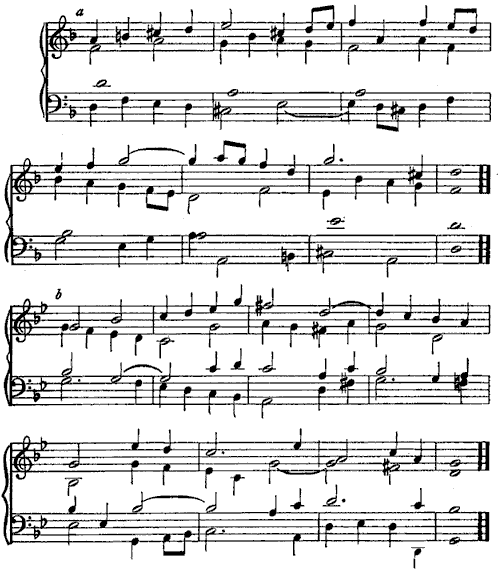 |
To the cantus firmus write the fifth species in all of the other parts. [Fig. 149a.]
Write four eight-measure phrases with the fifth species in all parts. [Fig. 149b.]
| Fig. 150. |
 |
| Fig. 151. |
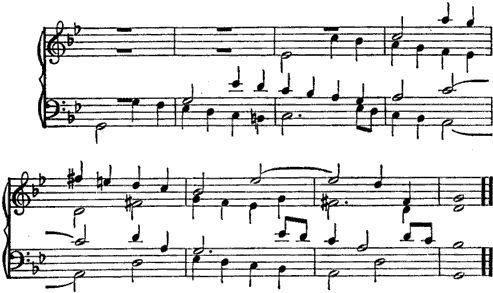 |
Write six eight-measure phrases, using the fifth species in all the parts. Let the parts begin one after the other in imitation. [Fig. 151.]
| Fig. 152. |
 |
Thus far, all notes in the measure foreign to the harmony on the first beat were treated as dissonances. Now, the cantus firmus may be harmonized at pleasure, the only restriction being that any tone foreign to the chord with which it enters must be treated as a dissonance. [Fig. 152.]
It is not necessary that each part be strictly florid, but that the effect of the parts as a whole should be so. This applies from this point to the end of these lessons.
The suspension may now be a quarter-note, or its rhythmic equivalent. It then comes on the first (a) or third (b) quarter of the measure, and the resolution on the quarter following. The preparation should be as long as, or longer than, the suspension. [Fig. 153.]
| Fig. 153. |
 |
The eighth-note as in Fig. 154a is good. It should be used only on the second half of a weak beat, and be preceded by a dotted quarter-note. Sixteenth-notes may be used in place of the eighth-note, but should be approached and left step-wise. [Fig. 154b.]
| Fig. 154. |
 |
The first species may be employed occasionally in the course of an exercise.
Make plentiful use of imitation.
When more than one line of a choral is used, it may be treated by having the other parts continue through the holds, as at a, or letting them rest, as at b. [Fig. 155.]
When, in place of the hold, the movement continues, it is necessary to interpolate a full measure in place of the hold. [Fig. 155 and Fig. 159.]
| Fig. 155. |
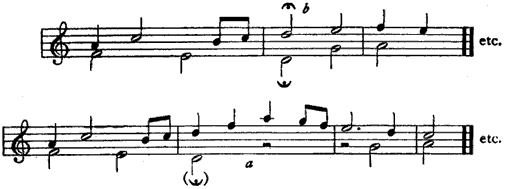 |
The note under the hold may be continued the extra measure, or the part may rest and then reėnter. All that is required is that it begin after the lapse of one measure, i.e., when the line ends on the accent the next line begins on the weak beat of the measure following, and if it ends on the weak beat then on the accent of the next measure.
The interval at any hold except the last of a choral may be either a perfect (a) or imperfect consonance (b). [Fig. 156.]
| Fig. 156. |
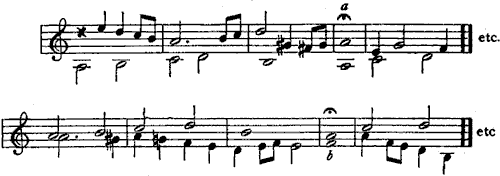 |
Modulation often occurs at the holds. If so, make it clear.
In this and in succeeding lessons set the cantus firmus in any part, and transpose if necessary.
To cantus firmus b write two counterpoints above and two below.
To cantus firmus a write one above and one below, with both parts resting at the hold. Also do the same with the counterpoint continuing at the hold. [Fig. 155a, b.]
| Fig. 157. |
 |
When writing in three or more parts, it is well to let a part rest occasionally, and, when it reėnters, have it imitate one of the other parts. [Fig. 158.]
| Fig. 158. |
 |
To cantus firmus a write two counterpoints above and two below in two-part counterpoint.
Write two original eight-measure phrases in two-part counterpoint.
To cantus firmus b write one example in three-part counterpoint with continuous movement at the hold. [Fig. 159.]
| Fig. 159. |
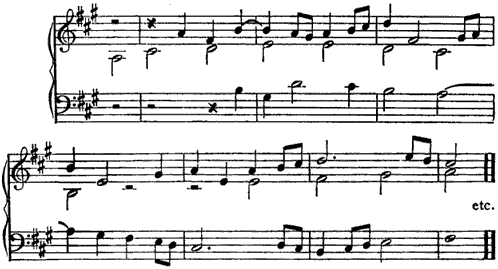 |
| Fig. 160. |
 |
To canti firmi a and b write two parts. Write each three times, setting the cantus firmus in all parts in turn. Write one of the solutions of the choral with continuous movement at the hold.
| Fig. 161. |
 |
Write two eight-measure phrases, and one sixteen-measure phrase, of original counterpoint in three parts.
| Fig. 162. |
 |
To the cantus firmus write three parts.
Write two sixteen-measure phrases of original four-part counterpoint, one major and one minor.
| Fig. 163. |
 |
In this and the following lessons have the parts in some of the exercises begin one after the other in imitation. [Fig. 151.]
Write two eight-measure phrases, and one sixteen-measure phrase, of original four-part counterpoint.
Write two sixteen-measure phrases of original four-part counterpoint.
Write an original exercise in four-part counterpoint, extended to thirty-two measures.
End of the Project Gutenberg EBook of A Treatise on Simple Counterpoint in
Forty Lessons, by Friedrich J. Lehmann
*** END OF THIS PROJECT GUTENBERG EBOOK A TREATISE ON SIMPLE ***
***** This file should be named 16342-h.htm or 16342-h.zip *****
This and all associated files of various formats will be found in:
https://www.gutenberg.org/1/6/3/4/16342/
Produced by David Newman, Dainis Millers and the Online
Distributed Proofreading Team at https://www.pgdp.net
Updated editions will replace the previous one--the old editions
will be renamed.
Creating the works from public domain print editions means that no
one owns a United States copyright in these works, so the Foundation
(and you!) can copy and distribute it in the United States without
permission and without paying copyright royalties. Special rules,
set forth in the General Terms of Use part of this license, apply to
copying and distributing Project Gutenberg-tm electronic works to
protect the PROJECT GUTENBERG-tm concept and trademark. Project
Gutenberg is a registered trademark, and may not be used if you
charge for the eBooks, unless you receive specific permission. If you
do not charge anything for copies of this eBook, complying with the
rules is very easy. You may use this eBook for nearly any purpose
such as creation of derivative works, reports, performances and
research. They may be modified and printed and given away--you may do
practically ANYTHING with public domain eBooks. Redistribution is
subject to the trademark license, especially commercial
redistribution.
*** START: FULL LICENSE ***
THE FULL PROJECT GUTENBERG LICENSE
PLEASE READ THIS BEFORE YOU DISTRIBUTE OR USE THIS WORK
To protect the Project Gutenberg-tm mission of promoting the free
distribution of electronic works, by using or distributing this work
(or any other work associated in any way with the phrase "Project
Gutenberg"), you agree to comply with all the terms of the Full Project
Gutenberg-tm License (available with this file or online at
https://gutenberg.org/license).
Section 1. General Terms of Use and Redistributing Project Gutenberg-tm
electronic works
1.A. By reading or using any part of this Project Gutenberg-tm
electronic work, you indicate that you have read, understand, agree to
and accept all the terms of this license and intellectual property
(trademark/copyright) agreement. If you do not agree to abide by all
the terms of this agreement, you must cease using and return or destroy
all copies of Project Gutenberg-tm electronic works in your possession.
If you paid a fee for obtaining a copy of or access to a Project
Gutenberg-tm electronic work and you do not agree to be bound by the
terms of this agreement, you may obtain a refund from the person or
entity to whom you paid the fee as set forth in paragraph 1.E.8.
1.B. "Project Gutenberg" is a registered trademark. It may only be
used on or associated in any way with an electronic work by people who
agree to be bound by the terms of this agreement. There are a few
things that you can do with most Project Gutenberg-tm electronic works
even without complying with the full terms of this agreement. See
paragraph 1.C below. There are a lot of things you can do with Project
Gutenberg-tm electronic works if you follow the terms of this agreement
and help preserve free future access to Project Gutenberg-tm electronic
works. See paragraph 1.E below.
1.C. The Project Gutenberg Literary Archive Foundation ("the Foundation"
or PGLAF), owns a compilation copyright in the collection of Project
Gutenberg-tm electronic works. Nearly all the individual works in the
collection are in the public domain in the United States. If an
individual work is in the public domain in the United States and you are
located in the United States, we do not claim a right to prevent you from
copying, distributing, performing, displaying or creating derivative
works based on the work as long as all references to Project Gutenberg
are removed. Of course, we hope that you will support the Project
Gutenberg-tm mission of promoting free access to electronic works by
freely sharing Project Gutenberg-tm works in compliance with the terms of
this agreement for keeping the Project Gutenberg-tm name associated with
the work. You can easily comply with the terms of this agreement by
keeping this work in the same format with its attached full Project
Gutenberg-tm License when you share it without charge with others.
1.D. The copyright laws of the place where you are located also govern
what you can do with this work. Copyright laws in most countries are in
a constant state of change. If you are outside the United States, check
the laws of your country in addition to the terms of this agreement
before downloading, copying, displaying, performing, distributing or
creating derivative works based on this work or any other Project
Gutenberg-tm work. The Foundation makes no representations concerning
the copyright status of any work in any country outside the United
States.
1.E. Unless you have removed all references to Project Gutenberg:
1.E.1. The following sentence, with active links to, or other immediate
access to, the full Project Gutenberg-tm License must appear prominently
whenever any copy of a Project Gutenberg-tm work (any work on which the
phrase "Project Gutenberg" appears, or with which the phrase "Project
Gutenberg" is associated) is accessed, displayed, performed, viewed,
copied or distributed:
This eBook is for the use of anyone anywhere at no cost and with
almost no restrictions whatsoever. You may copy it, give it away or
re-use it under the terms of the Project Gutenberg License included
with this eBook or online at www.gutenberg.org
1.E.2. If an individual Project Gutenberg-tm electronic work is derived
from the public domain (does not contain a notice indicating that it is
posted with permission of the copyright holder), the work can be copied
and distributed to anyone in the United States without paying any fees
or charges. If you are redistributing or providing access to a work
with the phrase "Project Gutenberg" associated with or appearing on the
work, you must comply either with the requirements of paragraphs 1.E.1
through 1.E.7 or obtain permission for the use of the work and the
Project Gutenberg-tm trademark as set forth in paragraphs 1.E.8 or
1.E.9.
1.E.3. If an individual Project Gutenberg-tm electronic work is posted
with the permission of the copyright holder, your use and distribution
must comply with both paragraphs 1.E.1 through 1.E.7 and any additional
terms imposed by the copyright holder. Additional terms will be linked
to the Project Gutenberg-tm License for all works posted with the
permission of the copyright holder found at the beginning of this work.
1.E.4. Do not unlink or detach or remove the full Project Gutenberg-tm
License terms from this work, or any files containing a part of this
work or any other work associated with Project Gutenberg-tm.
1.E.5. Do not copy, display, perform, distribute or redistribute this
electronic work, or any part of this electronic work, without
prominently displaying the sentence set forth in paragraph 1.E.1 with
active links or immediate access to the full terms of the Project
Gutenberg-tm License.
1.E.6. You may convert to and distribute this work in any binary,
compressed, marked up, nonproprietary or proprietary form, including any
word processing or hypertext form. However, if you provide access to or
distribute copies of a Project Gutenberg-tm work in a format other than
"Plain Vanilla ASCII" or other format used in the official version
posted on the official Project Gutenberg-tm web site (www.gutenberg.org),
you must, at no additional cost, fee or expense to the user, provide a
copy, a means of exporting a copy, or a means of obtaining a copy upon
request, of the work in its original "Plain Vanilla ASCII" or other
form. Any alternate format must include the full Project Gutenberg-tm
License as specified in paragraph 1.E.1.
1.E.7. Do not charge a fee for access to, viewing, displaying,
performing, copying or distributing any Project Gutenberg-tm works
unless you comply with paragraph 1.E.8 or 1.E.9.
1.E.8. You may charge a reasonable fee for copies of or providing
access to or distributing Project Gutenberg-tm electronic works provided
that
- You pay a royalty fee of 20% of the gross profits you derive from
the use of Project Gutenberg-tm works calculated using the method
you already use to calculate your applicable taxes. The fee is
owed to the owner of the Project Gutenberg-tm trademark, but he
has agreed to donate royalties under this paragraph to the
Project Gutenberg Literary Archive Foundation. Royalty payments
must be paid within 60 days following each date on which you
prepare (or are legally required to prepare) your periodic tax
returns. Royalty payments should be clearly marked as such and
sent to the Project Gutenberg Literary Archive Foundation at the
address specified in Section 4, "Information about donations to
the Project Gutenberg Literary Archive Foundation."
- You provide a full refund of any money paid by a user who notifies
you in writing (or by e-mail) within 30 days of receipt that s/he
does not agree to the terms of the full Project Gutenberg-tm
License. You must require such a user to return or
destroy all copies of the works possessed in a physical medium
and discontinue all use of and all access to other copies of
Project Gutenberg-tm works.
- You provide, in accordance with paragraph 1.F.3, a full refund of any
money paid for a work or a replacement copy, if a defect in the
electronic work is discovered and reported to you within 90 days
of receipt of the work.
- You comply with all other terms of this agreement for free
distribution of Project Gutenberg-tm works.
1.E.9. If you wish to charge a fee or distribute a Project Gutenberg-tm
electronic work or group of works on different terms than are set
forth in this agreement, you must obtain permission in writing from
both the Project Gutenberg Literary Archive Foundation and Michael
Hart, the owner of the Project Gutenberg-tm trademark. Contact the
Foundation as set forth in Section 3 below.
1.F.
1.F.1. Project Gutenberg volunteers and employees expend considerable
effort to identify, do copyright research on, transcribe and proofread
public domain works in creating the Project Gutenberg-tm
collection. Despite these efforts, Project Gutenberg-tm electronic
works, and the medium on which they may be stored, may contain
"Defects," such as, but not limited to, incomplete, inaccurate or
corrupt data, transcription errors, a copyright or other intellectual
property infringement, a defective or damaged disk or other medium, a
computer virus, or computer codes that damage or cannot be read by
your equipment.
1.F.2. LIMITED WARRANTY, DISCLAIMER OF DAMAGES - Except for the "Right
of Replacement or Refund" described in paragraph 1.F.3, the Project
Gutenberg Literary Archive Foundation, the owner of the Project
Gutenberg-tm trademark, and any other party distributing a Project
Gutenberg-tm electronic work under this agreement, disclaim all
liability to you for damages, costs and expenses, including legal
fees. YOU AGREE THAT YOU HAVE NO REMEDIES FOR NEGLIGENCE, STRICT
LIABILITY, BREACH OF WARRANTY OR BREACH OF CONTRACT EXCEPT THOSE
PROVIDED IN PARAGRAPH F3. YOU AGREE THAT THE FOUNDATION, THE
TRADEMARK OWNER, AND ANY DISTRIBUTOR UNDER THIS AGREEMENT WILL NOT BE
LIABLE TO YOU FOR ACTUAL, DIRECT, INDIRECT, CONSEQUENTIAL, PUNITIVE OR
INCIDENTAL DAMAGES EVEN IF YOU GIVE NOTICE OF THE POSSIBILITY OF SUCH
DAMAGE.
1.F.3. LIMITED RIGHT OF REPLACEMENT OR REFUND - If you discover a
defect in this electronic work within 90 days of receiving it, you can
receive a refund of the money (if any) you paid for it by sending a
written explanation to the person you received the work from. If you
received the work on a physical medium, you must return the medium with
your written explanation. The person or entity that provided you with
the defective work may elect to provide a replacement copy in lieu of a
refund. If you received the work electronically, the person or entity
providing it to you may choose to give you a second opportunity to
receive the work electronically in lieu of a refund. If the second copy
is also defective, you may demand a refund in writing without further
opportunities to fix the problem.
1.F.4. Except for the limited right of replacement or refund set forth
in paragraph 1.F.3, this work is provided to you 'AS-IS', WITH NO OTHER
WARRANTIES OF ANY KIND, EXPRESS OR IMPLIED, INCLUDING BUT NOT LIMITED TO
WARRANTIES OF MERCHANTIBILITY OR FITNESS FOR ANY PURPOSE.
1.F.5. Some states do not allow disclaimers of certain implied
warranties or the exclusion or limitation of certain types of damages.
If any disclaimer or limitation set forth in this agreement violates the
law of the state applicable to this agreement, the agreement shall be
interpreted to make the maximum disclaimer or limitation permitted by
the applicable state law. The invalidity or unenforceability of any
provision of this agreement shall not void the remaining provisions.
1.F.6. INDEMNITY - You agree to indemnify and hold the Foundation, the
trademark owner, any agent or employee of the Foundation, anyone
providing copies of Project Gutenberg-tm electronic works in accordance
with this agreement, and any volunteers associated with the production,
promotion and distribution of Project Gutenberg-tm electronic works,
harmless from all liability, costs and expenses, including legal fees,
that arise directly or indirectly from any of the following which you do
or cause to occur: (a) distribution of this or any Project Gutenberg-tm
work, (b) alteration, modification, or additions or deletions to any
Project Gutenberg-tm work, and (c) any Defect you cause.
Section 2. Information about the Mission of Project Gutenberg-tm
Project Gutenberg-tm is synonymous with the free distribution of
electronic works in formats readable by the widest variety of computers
including obsolete, old, middle-aged and new computers. It exists
because of the efforts of hundreds of volunteers and donations from
people in all walks of life.
Volunteers and financial support to provide volunteers with the
assistance they need, is critical to reaching Project Gutenberg-tm's
goals and ensuring that the Project Gutenberg-tm collection will
remain freely available for generations to come. In 2001, the Project
Gutenberg Literary Archive Foundation was created to provide a secure
and permanent future for Project Gutenberg-tm and future generations.
To learn more about the Project Gutenberg Literary Archive Foundation
and how your efforts and donations can help, see Sections 3 and 4
and the Foundation web page at https://www.pglaf.org.
Section 3. Information about the Project Gutenberg Literary Archive
Foundation
The Project Gutenberg Literary Archive Foundation is a non profit
501(c)(3) educational corporation organized under the laws of the
state of Mississippi and granted tax exempt status by the Internal
Revenue Service. The Foundation's EIN or federal tax identification
number is 64-6221541. Its 501(c)(3) letter is posted at
https://pglaf.org/fundraising. Contributions to the Project Gutenberg
Literary Archive Foundation are tax deductible to the full extent
permitted by U.S. federal laws and your state's laws.
The Foundation's principal office is located at 4557 Melan Dr. S.
Fairbanks, AK, 99712., but its volunteers and employees are scattered
throughout numerous locations. Its business office is located at
809 North 1500 West, Salt Lake City, UT 84116, (801) 596-1887, email
business@pglaf.org. Email contact links and up to date contact
information can be found at the Foundation's web site and official
page at https://pglaf.org
For additional contact information:
Dr. Gregory B. Newby
Chief Executive and Director
gbnewby@pglaf.org
Section 4. Information about Donations to the Project Gutenberg
Literary Archive Foundation
Project Gutenberg-tm depends upon and cannot survive without wide
spread public support and donations to carry out its mission of
increasing the number of public domain and licensed works that can be
freely distributed in machine readable form accessible by the widest
array of equipment including outdated equipment. Many small donations
($1 to $5,000) are particularly important to maintaining tax exempt
status with the IRS.
The Foundation is committed to complying with the laws regulating
charities and charitable donations in all 50 states of the United
States. Compliance requirements are not uniform and it takes a
considerable effort, much paperwork and many fees to meet and keep up
with these requirements. We do not solicit donations in locations
where we have not received written confirmation of compliance. To
SEND DONATIONS or determine the status of compliance for any
particular state visit https://pglaf.org
While we cannot and do not solicit contributions from states where we
have not met the solicitation requirements, we know of no prohibition
against accepting unsolicited donations from donors in such states who
approach us with offers to donate.
International donations are gratefully accepted, but we cannot make
any statements concerning tax treatment of donations received from
outside the United States. U.S. laws alone swamp our small staff.
Please check the Project Gutenberg Web pages for current donation
methods and addresses. Donations are accepted in a number of other
ways including including checks, online payments and credit card
donations. To donate, please visit: https://pglaf.org/donate
Section 5. General Information About Project Gutenberg-tm electronic
works.
Professor Michael S. Hart was the originator of the Project Gutenberg-tm
concept of a library of electronic works that could be freely shared
with anyone. For thirty years, he produced and distributed Project
Gutenberg-tm eBooks with only a loose network of volunteer support.
Project Gutenberg-tm eBooks are often created from several printed
editions, all of which are confirmed as Public Domain in the U.S.
unless a copyright notice is included. Thus, we do not necessarily
keep eBooks in compliance with any particular paper edition.
Most people start at our Web site which has the main PG search facility:
https://www.gutenberg.org
This Web site includes information about Project Gutenberg-tm,
including how to make donations to the Project Gutenberg Literary
Archive Foundation, how to help produce our new eBooks, and how to
subscribe to our email newsletter to hear about new eBooks.
*** END: FULL LICENSE ***